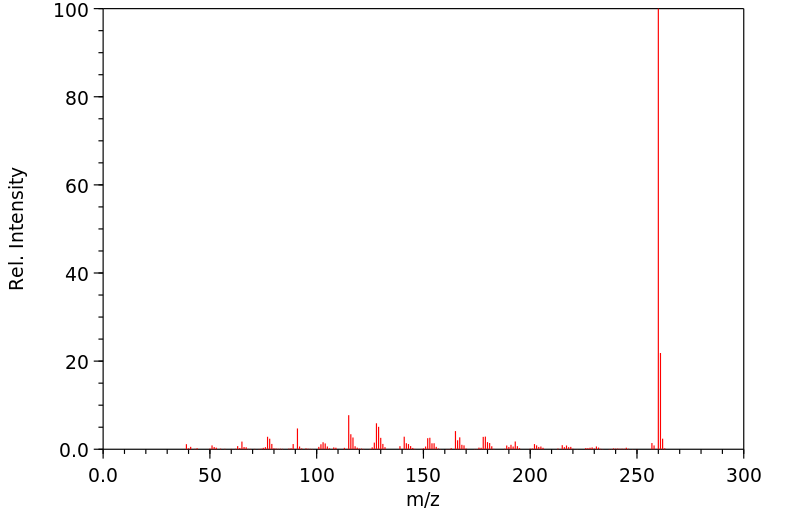正十二面烷 | 4493-23-6
中文名称
正十二面烷
中文别名
——
英文名称
dodecahedrane
英文别名
Dodecahedran;undecacyclo[9.9.0.02,9.03,7.04,20.05,18.06,16.08,15.010,14.012,19.013,17]icosane
CAS
4493-23-6
化学式
C20H20
mdl
——
分子量
260.379
InChiKey
OOHPORRAEMMMCX-UHFFFAOYSA-N
BEILSTEIN
——
EINECS
——
-
物化性质
-
计算性质
-
ADMET
-
安全信息
-
SDS
-
制备方法与用途
-
上下游信息
-
文献信息
-
表征谱图
-
同类化合物
-
相关功能分类
-
相关结构分类
物化性质
-
熔点:>450°
计算性质
-
辛醇/水分配系数(LogP):2.9
-
重原子数:20
-
可旋转键数:0
-
环数:12.0
-
sp3杂化的碳原子比例:1.0
-
拓扑面积:0
-
氢给体数:0
-
氢受体数:0
SDS
上下游信息
-
上游原料
中文名称 英文名称 CAS号 化学式 分子量 —— undecacyclo<9.9.0.01,5.02,12.02,18.03,7.06,10.08,12.011,15.013,17.016,20>icosane 89683-62-5 C20H20 260.379
反应信息
-
作为反应物:参考文献:名称:Dodecahedrane. Improved synthetic access to, and monofunctionalization of, the spherical hydrocarbon. Spectral properties of the derivatives摘要:DOI:10.1021/ja00234a003
-
作为产物:描述:1,6-Dibromdodecahedran 在 三(三甲基硅基)硅烷 作用下, 以 苯 为溶剂, 反应 2.0h, 以99%的产率得到正十二面烷参考文献:名称:Wahl, Fabian; Woerth, Juergen; Prinzbach, Horst, Angewandte Chemie, 1993, vol. 105, # 12, p. 1788 - 1791摘要:DOI:
文献信息
-
From unsaturated dodecahedranes to C40 cages?作者:Klaus Weber、Thorsten Voss、Dirk Heimbach、Andreas Weiler、Manfred Keller、Jürgen Wörth、Lothar Knothe、Kai Exner、Horst PrinzbachDOI:10.1016/j.tetlet.2005.06.072日期:2005.8(2+2)-Dimerization of unsaturated, highly pyramidalized dodecahedranes (Φ = 43–45°) is explored as a route to C40-cage molecules and non-classical ions derived thereby. The cycloadducts (X-ray structure) formed under vigorous conditions either in solution or in the solid phase above 300 °C did not undergo 2σ → 2π isomerization. The MS fragmentation patterns, in line with calculations (B3LYP/6-31G*)(2 + 2)-不饱和高度金字塔化的十二面体(Φ = 43–45°)的二聚化被探索为通往C 40笼状分子和由此衍生的非经典离子的途径。在溶液中或在高于300°C的固相中,在剧烈条件下形成的环加合物(X射线结构)未经历2σ →2π异构化。与计算结果(B3LYP / 6-31G *)一致,MS碎片模式表明形成了“开放式” C 40指示剂。
-
From Pagodanes to Dodecahedranes - Search for a Serviceable Access to the Parent (C 20 H 20 ) Hydrocarbon ** **Dedicated to Professor W. von E. Doering on the occasion of his 80th birthday. H.P. very fondly remembers his two post-doc years at Yale University (1957–59).作者:Martin Bertau、Fabian Wahl、Andreas Weiler、Klaus Scheumann、Jürgen Wörth、Manfred Keller、Horst PrinzbachDOI:10.1016/s0040-4020(97)00345-1日期:1997.7novel SN2 pagodane → dodecahedrane routes a preparatively potent access to the parent pentagonal dodecahedrane (2) was explored. The one-pot catalytic procedure (Pd/C/H2) starting from an eightfold functionalized secopagodane (14, C20H12Br6 (CO2 CH3)2) excells in shortness but, rather erratic (33–53%), falls out of the competition. The longer route via 1,6-dicarboxyl/dibromo dodecahedranes (35, 22)通过利用新颖的S N 2 pagodane→十二面体路线,探索了对母体五边形十二面体的有效制备途径(2)。一锅催化程序(Pd / C / H 2)从八倍官能化的二十二碳五烷(14,C 20 H 12 Br 6(CO 2 CH 3)2)开始,但在短时间内却表现不佳,但不稳定(33-53%) ,从竞争中脱颖而出。经由较长的路线1,6-二羧基/二溴dodecahedranes(35,22原来作为首选与基于公共pagodane前体的74-76%的总产率)(13)。©1997爱思唯尔科学有限公司。
-
Dodecahedryl Anion Formation and an Experimental Determination of the Acidity and C−H Bond Dissociation Energy of Dodecahedrane作者:Katherine M. Broadus、Steven R. Kass、Thomas Osswald、Horst PrinzbachDOI:10.1021/ja002588f日期:2000.11.1405.1 kcal/mol. In a similar manner, the electron affinity of dodecahedryl radical was measured (EA = 4 ± 2 kcal/mol). These results were combined in a thermodynamic cycle to afford the C−H bond dissociation energy of dodecahedrane (BDE = 92 ± 3 kcal/mol), which is reasonably well reproduced (96.7 kcal/mol) at the MP2//HF level but leads to the suggestion that the reported heat of hydrogenation of dodecahedrene十二面体阴离子 (1a) 在傅立叶变换质谱仪中通过十二面体 (1) 的去质子化生成。分别检查 1 和 1a 的酸和碱行为,可以确定 1 的酸度(ΔH°酸 = 402 ± 2 kcal/mol)。发现与 298 K 计算的 MP2/6-31+G(d)//HF/6-31+G(d) 值 405.1 kcal/mol 具有良好的一致性。以类似的方式,测量了十二面体自由基的电子亲和力(EA = 4 ± 2 kcal/mol)。这些结果结合在一个热力学循环中以提供十二面体的 C−H 键解离能 (BDE = 92 ± 3 kcal/mol),在 MP2//HF 水平上可以很好地再现 (96.7 kcal/mol),但领先建议报告的十二面体氢化热是错误的。还探索了用于测量 1 酸度的 DePuy 动力学方法。发现这种方法对三苯基甲硅烷基十二面体效果很好,但对三乙基甲硅烷基十二面体效果不佳。后者的失败归因于
-
Towards Perfunctionalized Dodecahedranes—En Route to C20 Fullerene作者:Fabian Wahl、Andreas Weiler、Peter Landenberger、Emmerich Sackers、Torsten Voss、Alois Haas、Max Lieb、Dieter Hunkler、Jürgen Wörth、Lothar Knothe、Horst PrinzbachDOI:10.1002/chem.200501618日期:2006.8.16"One-pot" substitution of the twenty hydrogen atoms in pentagonal dodecahedrane (C(20)H(20)) by OH, F, Cl, and Br atoms is explored. Electrophilic insertion of oxygen atoms with DMDO and TFMDO as oxidizing reagents ended, far off the desired C(20)(OH)(20), in complex polyol mixtures (up to C(20)H(10)(OH)(10) decols, a trace of C(20)H(OH)(19)?). Perfluorination was successful in a NaF matrix but (nearly探索了通过OH,F,Cl和Br原子对五角形十二面体(C(20)H(20))中的二十个氢原子进行“一锅”取代。在复杂多元醇混合物中(高达C(20)H(10)(OH)(10)),以DMDO和TFMDO作为氧化剂的氧原子亲电插入结束,与所需的C(20)(OH)(20)距离很远。 decols,微量的C(20)H(OH)(19)?)。全氟化在NaF基质中是成功的,但是(几乎纯净的)C(20)F(20)只能以非常低的产率得到保证。“强力”光氯化(加热,光照,压力,时间)提供了高产率的无氢,难溶的C(20)Cl(16)二烯和C(20)Cl(20)的混合物。 。C-(20)Cl(16)材料的电子碰撞电离后,氯原子的顺序损失是主要的裂解途径,但是,仅少量的无氯C(20)(+)离子。“强力”光溴化法将质量最高的多溴化物与C(20)HBr(13)三烯的混合物非常复杂。MS谱图显示Br取代基的排他性损失,最终以
-
Prinzbach, Horst; Weber, Klaus, Angewandte Chemie, 1994, vol. 106, # 22, p. 2329 - 2348作者:Prinzbach, Horst、Weber, KlausDOI:——日期:——
表征谱图
-
氢谱1HNMR
-
质谱MS
-
碳谱13CNMR
-
红外IR
-
拉曼Raman
-
峰位数据
-
峰位匹配
-
表征信息
同类化合物
(5β,6α,8α,10α,13α)-6-羟基-15-氧代黄-9(11),16-二烯-18-油酸
(3S,3aR,8aR)-3,8a-二羟基-5-异丙基-3,8-二甲基-2,3,3a,4,5,8a-六氢-1H-天青-6-酮
(2Z)-2-(羟甲基)丁-2-烯酸乙酯
(2S,4aR,6aR,7R,9S,10aS,10bR)-甲基9-(苯甲酰氧基)-2-(呋喃-3-基)-十二烷基-6a,10b-二甲基-4,10-dioxo-1H-苯并[f]异亚甲基-7-羧酸盐
(1aR,4E,7aS,8R,10aS,10bS)-8-[((二甲基氨基)甲基]-2,3,6,7,7a,8,10a,10b-八氢-1a,5-二甲基-氧杂壬酸[9,10]环癸[1,2-b]呋喃-9(1aH)-酮
(+)顺式,反式-脱落酸-d6
龙舌兰皂苷乙酯
龙脑香醇酮
龙脑烯醛
龙脑7-O-[Β-D-呋喃芹菜糖基-(1→6)]-Β-D-吡喃葡萄糖苷
龙牙楤木皂甙VII
龙吉甙元
齿孔醇
齐墩果醛
齐墩果酸苄酯
齐墩果酸甲酯
齐墩果酸溴乙酯
齐墩果酸二甲胺基乙酯
齐墩果酸乙酯
齐墩果酸3-O-alpha-L-吡喃鼠李糖基(1-3)-beta-D-吡喃木糖基(1-3)-alpha-L-吡喃鼠李糖基(1-2)-alpha-L-阿拉伯糖吡喃糖苷
齐墩果酸 beta-D-葡萄糖酯
齐墩果酸 beta-D-吡喃葡萄糖基酯
齐墩果酸 3-乙酸酯
齐墩果酸 3-O-beta-D-葡吡喃糖基 (1→2)-alpha-L-吡喃阿拉伯糖苷
齐墩果酸
齐墩果-12-烯-3b,6b-二醇
齐墩果-12-烯-3,24-二醇
齐墩果-12-烯-3,21,23-三醇,(3b,4b,21a)-(9CI)
齐墩果-12-烯-3,21,23-三醇,(3b,4b,21a)-(9CI)
齐墩果-12-烯-3,11-二酮
齐墩果-12-烯-2α,3β,28-三醇
齐墩果-12-烯-29-酸,3,22-二羟基-11-羰基-,g-内酯,(3b,20b,22b)-
齐墩果-12-烯-28-酸,3-[(6-脱氧-4-O-b-D-吡喃木糖基-a-L-吡喃鼠李糖基)氧代]-,(3b)-(9CI)
齐墩果-12-烯-28-酸,3,7-二羰基-(9CI)
齐墩果-12-烯-28-酸,3,21,29-三羟基-,g-内酯,(3b,20b,21b)-(9CI)
鼠特灵
鼠尾草酸醌
鼠尾草酸
鼠尾草酚酮
鼠尾草苦内脂
黑蚁素
黑蔓醇酯B
黑蔓醇酯A
黑蔓酮酯D
黑海常春藤皂苷A1
黑檀醇
黑果茜草萜 B
黑五味子酸
黏黴酮
黏帚霉酸







